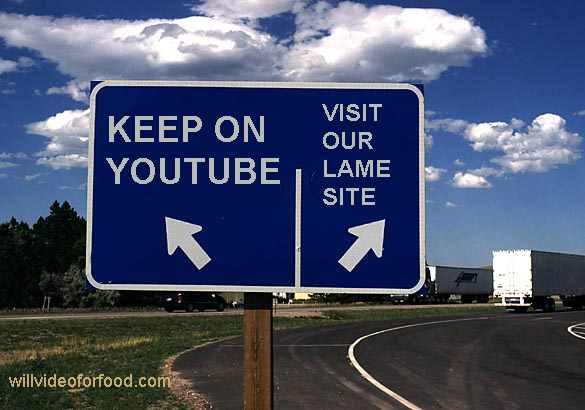Using Online Video to Promote Business: BS in WSJ
 Today’s Wall Street Journal has an article by Raymund Flandez called “Lights, Camera, Sales: How to Use Video to Expand Your Business in a YouTube World.” It’s positioned on the front page as “Small Business: How to Use Video to Grow.”
Today’s Wall Street Journal has an article by Raymund Flandez called “Lights, Camera, Sales: How to Use Video to Expand Your Business in a YouTube World.” It’s positioned on the front page as “Small Business: How to Use Video to Grow.”
I’ve got some issues with the piece, and not just because Flandez didn’t interview The Viral Video Genius. The article lists some nice case studies — from Blendec’s popular “Will it Blend” series (which drove sales up 500% to $40 million) to a clever “Free Range Root Beer” campaign by All Natural Main Root. I hadn’t heard of this series, yet the late-night breakin by root-beer activists is clever and only mildly over acted. But…
But there are a few things in the WSJ article that make my BS alarmgo off. Buckle up, readers, this is an must-read WillVideoForFood post.
 The WSJ reports that Moe’s Southwest Grill did a video contest where it received 40 submissions and got 211K visitors. That’s not bad vital signs for a video contest, although I’d guess the cost per lead was exponentially more than it would cost to run a decent paid-search campaign– given the fixed costs of promoting and running the contest. Hopefully the video entries were viewed in other places beyond the contest site (a vital element to the performance of a campaign unless it’s a strict “lead generation” or transactional direct-response play).
The WSJ reports that Moe’s Southwest Grill did a video contest where it received 40 submissions and got 211K visitors. That’s not bad vital signs for a video contest, although I’d guess the cost per lead was exponentially more than it would cost to run a decent paid-search campaign– given the fixed costs of promoting and running the contest. Hopefully the video entries were viewed in other places beyond the contest site (a vital element to the performance of a campaign unless it’s a strict “lead generation” or transactional direct-response play).- When I read that Moe’s “email marketing database also grew to 200,000,” I can’t help but wonder if it was 195,000 before the contest. Something tells me just a few thousand of the 211K visitors signed up for e-mails (maybe 5 percent) from Moe’s Grill. I can’t recall if providing your e-mail was a prerequisite to voting, but that’s the only way the conversion was higher (and are those good email leads or sock accounts for someone who wanted to jack up votes for their friends’ video?). The contest site, like many of its kind, appears RIP right now (this is why we outsource contests, marketers): http://www.moes.com/burritosforlife. Here’s a link to a rap entry to the Moe’s contest.
- The Kelsey Group surveyed 501 adults in February and reports that 59% had viewed a video ad on the Internet. Technical foul! That question leaves way too much room for interpretation— was it a preroll ad or an entertaining promotional video like those highlighted in the WSJ article?
There’s a big difference between vaguely recalling a Toyota video preroll ad that tortured me as I an anticipated an SNL clip, versus buying a painting on eBay because the artist posted videos of herself creating the piece (Valentina Trevino).
- Finally, the WSJ reports that the Kelsey Group claims 59% of adults answered “yes” to viewing a “video ad,” 43 percent “checked out a website.” A professor once told me that statistics are like hookers — you can get them to do or say anything you want. That number simply means that almost half of folks who once saw an ad once checked out a website… at some point in their lonely life. People- rest assured that this is the most misleading statistic of online video, and sets brands up for horrific disappointment. Your online video “ads” will not get many people to check out your website. Sorry. If you get more than a few percent you should be delighted. If your campaign hinges on a view-to-visit ratio (especially if you’re selling something with small margins), then your ROI will simply depend on keeping your production costs down to barely nothing or getting the video miraculously viewed 10 million times.
- Yes, there’s “lights, camera, sales.” But there’s a lotsitting between “the lights and camera” and “sales.” For every Blendtec there are countless failed online-video campaigns that were over-baked and lost in the shuffle.
Ahh. I feel better now that I’ve done the standard “arrogant blogger throws mud at WSJ writer who didn’t interview him” drill. Now it’s time for some basic reminders, and this should be required reading for anyone that got googly eyed from reading the WSJ article:
KEY VIRAL VIDEO REMINDERS
 You gotta throw a lot of spaghetti on the wall and watch what sticks. It’s still hard to say what people like about online videos (although funny, short, visceral and “big finish” are important ingredients). I’ve done more than 500 online videos and still can’t predict what will sail or sink. For every “Vals Art Diary” there are thousands of overproduced (and sometimes even clever) marketing videos that are buried in the bowls of YouTube. For every “Farting in Public” (which just cracked 4 million views) there’s a “Prisoner of Best Buy” (a video I shot this morning, but is doomed to never be seen beyond 20K times because I actually like it). So what’s that mean? Experiment.
You gotta throw a lot of spaghetti on the wall and watch what sticks. It’s still hard to say what people like about online videos (although funny, short, visceral and “big finish” are important ingredients). I’ve done more than 500 online videos and still can’t predict what will sail or sink. For every “Vals Art Diary” there are thousands of overproduced (and sometimes even clever) marketing videos that are buried in the bowls of YouTube. For every “Farting in Public” (which just cracked 4 million views) there’s a “Prisoner of Best Buy” (a video I shot this morning, but is doomed to never be seen beyond 20K times because I actually like it). So what’s that mean? Experiment.- To get a decent ROI, you need to keep your costs down. Otherwise you’re going to have a tough time capturing measurable value that offsets a $50-$500K pilot. You can dip your toe in the water for just thousands simply by partnering with known “weblebrities” who often promote products and services for a small fee, and already have an established audience. A few grand with a weblebrity gets you a video, their halo effect, and nearly guaranteed views of 10-100K. That same amount will get you an afternoon of a large agency fees.
- If you decide you want to produce your own content, be prepared to market the heck out of it. The viral video is just the germ- you still need to help spread the virus on airplanes, door knobs and at Chuck-E-Cheese. And don’t trust that “interactive guy” at the ad agency or PR firm to promote your baby. Find someone that has driven lots of views, and put that experience to work.
- When you measure return, consider the total video views beyond your site. Only a few percent will veer off the YouTube highway to visit your promotional rest stop unless there’s food and bathrooms. To bridge the gap, lure viewers with additional entertainment or value, or at least a unique URL. Those viewing MrComplicated (see background on CNN Money) were obviously far more likely to visit MrComplicated.com than Clear-Point.com (the sponsor’s site).
 Be sure to decide the objective of the campaign and remember that objective when it’s time to assess performance. I’ve seen too many companies begin with a goal to get e-mail addresses, for instance, and then get giddy about total views and the homepage feature on Eefoof (yes, Marquis, it’s finally dead- I checked). Similarly, some brands plunge into online video simply for the public relations value, and then lament low views. Who cares about visits to your stupid brochureware site if you got the views and press (even if it’s consumer-generated media) you were after? People don’t need to lick a Coke billboard to be compelled to buy colored sugar water with red wrappers instead of blue. Dang I’m full of metaphors today. Is anyone writing this stuff down?
Be sure to decide the objective of the campaign and remember that objective when it’s time to assess performance. I’ve seen too many companies begin with a goal to get e-mail addresses, for instance, and then get giddy about total views and the homepage feature on Eefoof (yes, Marquis, it’s finally dead- I checked). Similarly, some brands plunge into online video simply for the public relations value, and then lament low views. Who cares about visits to your stupid brochureware site if you got the views and press (even if it’s consumer-generated media) you were after? People don’t need to lick a Coke billboard to be compelled to buy colored sugar water with red wrappers instead of blue. Dang I’m full of metaphors today. Is anyone writing this stuff down?
For those of you with short attention span, I’ve summarized this post in this visual of a video virus magnified 2 billion times:
Sidebar: Flandez interviews David Meerman Scott, author of “The New Rules of Marketing and PR” in this interesting video that features an obnoxious preroll. I hadn’t heard of Scott, but was pleased to discover his books and blog.



Hey Kevin, Thanks for the mention of my quote in this post. While experts like you may not find the WSJ piece compelling, remember the audience. The WSJ appeals to people who read print and many run their own businesses. Many wouldn’t know a blog if it bit them on the bum, I think Raymund did a great job introducing people to the YouTube video as marketing tool concept. Remember, many people reading this have not been exposed to this before and are still relying on the Yellow Pages.
Many people who read my book are beginners and they love this basic information.
Take care, David
Nalts, what do you know about the company/website VBN.tv? Some people have expressed interest to me about this website and hosting a show on it. It does utilize direct marketing a bit more with links to product placements, so I don’t think it will be for everyone. But, who gets the best shake from this site? Is there room on this site to sell the product (me/my website) or would I just be a delivery device to sell the internal products. Profit sharing is another thing to consider, but do you think videos on this site would generate much traffic back to the me product/site?
Nick- don’t know VBN.
David- fair point. The article and his interview did a masterful job of finding good examples for small business and simplifying the concept. It’s the stats without caveats that scare me. It sets people up for an artificially high/low sense of success. Causing them to dump money or toss the baby with the bathwater (two sad extreme reactions that are almost instinctive in a “new” space like this).
Give it a look if you get the chance. I would like to see what the Viral Video Genius would have to say about it. Especially given your marketing background and knowledge base. Also, there seem to be A LOT of online video sites popping up that promise the moon, but seem to either miss the mark or need to retool months down the road.
I hope companies notice your info and click your “hire Nalts” button. It would be money well spent. Thanks for the substantive posts.
Congrats on the cnnmoney.com article. I hadn’t seen that yet.
Hey kevin,eefoof isnt actually dead,theyre back,and worse than ever as vume! At the bottom of their homepage it still says “copyright 2007 eefoof”,every day it seems like a few more features mysteriously stop working.Btw,congrats on your farting in public video,it just hit 4 million views!
I read every word and particularly like the hooker statistics metaphor. Complementary Mark Twain Quote Here. Having had the opportunity to manipulate statistics in the past – class assignment – I know how easy it is to do and if you have the gift for gab you can make a very compelling case to your audience or reader.
In no particular order:
I think advertising in business is a little different than selling video content on line, I don’t think the masses have bought into supporting that yet and they are trained in the area of, ‘I give you money you give me something in return’; even to supposed good causes like PBS. Also, the net has the identity of “FREE STUFF” hovering over it still, and when it comes to tangibles (though this is changing) most people still want to touch things first. Conducting polls and surveys are also sketchy business, people will often tell you what they think you want to hear or say things that make them seem smart or in the know, unless they know you.
That said, and I agree with a lot of what you said Kevin, in regards to on-line viral video and making money I think unless you have something people really need or are specifically looking for the best method to get them to buy what you are selling is to:
Yes, “market the heck out of it.”
1. Inundate them with the product: Head On! Head On! One of the most annoying and successful product ads in history. (also see past posts regarding the new field/position of promoting uploading etc.. people’s work on-line).
Yes, “decide the objective of the campaign”
2. Beg: Constantly reminding your audience you have something of value to sell or that purchasing a product or donating are supporting your efforts to continue. This method requires sincerity and some charisma.
I know this is far down on the totem, but what Mark Day has done with his reminder of 5 Staring his videos is really very good salesmanship.
zefrank’s candy, though uncertain how successful that was; parting with cash for content is tough, requires some pride swallowing as well. However, he did show how one could beg/ask ‘content for cash’ with little criticisms and style.
One of the most compelling, successfully and almost required areas for selling that has popped up over the past few decades is the Mission Statement. People want to know what your intentions are, your story and where you are headed. There isn’t a major organization or business that doesn’t have one of these.
Show me the money!: Who is spending? Retiring Baby Boomers and Gen Y. Boomers are on their way out, they want something meaningful before they go and Gen Y is asking, “Why must I wait for something meaningful, why can’t I have it today?”
People aren’t settling for, ‘Here’s my money now give me my thing,
Ka Ching! See ya later.’ They’re going Green! They want to makes a contribution or purchase with purpose and that is where the the real numbers are.
If you are so inclined, between now and Christmas do something for a good cause. Grab the code for The Hunger Site, (click my name) put the code on your web page. Make your regular video, at the end mention in text:
Click the link in the side bar (your web page)
Click the button The Hunger Site
Help Feed The Hungry
“If you decide you want to produce your own content, be prepared to market the heck out of it.”
Amen, brother, amen! You have no idea how many Silicon Valley entrepreneurs told me that their video was the marketing. They’d dump something on YouTube, and when it didn’t generate a million views, used it as proof that viral marketing doesn’t work.
By the way, these were the same overfunded doorknobs who asked me to videotape one of their executives in the boardroom and, citing LonelyGirl15, postulated that a talking head is all that’s required to go viral!
We may be at Web 2.0, but the execs are still in beta.
1. I have a short attention span… I like pictures.
2. Statistics are bullshit… I am a social worker and have been to meetings at the mayors office regarding getting statistics of the homeless population in San Francisco. I walked away from that meeting with a new outlook on statistics.
3. WSJ sucks!… stick to Maxim Magazine.
Great post… Lots to remember here about regular advertising tactics as they apply to online video.
I think that when it comes to garnering results from advertising, online video is not that different a medium as TV or radio or even print. It’s the old postulate about sending “the Right Message to the Right People at the Right Time and Place.” The difference in online video is the specificity of choices when it comes to what The Public wants to view. How The Public responds to advertising isn’t really that different.
If you want to produce a “traditional” video ad, and run it online, you gotta run it OFTEN (frequency is STILL the best way to get results if you ask me) — WAY more often than an ad may be broadcast on TV, because of the vast fragmentation of the online video audience. And you have to run it on the sites where your prospective consumers congregate. A spot that runs on YouTube for an auto repair joint in Bangor Maine won’t get nearly as much ROI as if you post the video on maineautosearch.com, a local used auto dealer site. The old adage is “all advertising is local.” So, localize your online marketing! You may not get millions of views, but you’ll get a higher percentage of quality inquiries…
… That is, of course, if your message is salient and entertaining enough to be remembered, and then acted upon.
I agree Slater if you are selling siding or coffins, but what about viral video. Entertainment?
The highest rated videos on you tube consistently are near naked chicks and people getting hurt or doing/saying stupid things. $ex and violence still sell big when it comes to entertainment. So having a loyal audience is probably the most important thing right now in viral video. I wonder if that is part of the human need for leadership?
Awesome post!!
Very Informative. Thanks
I love how the topic is on video and no one has posted a link or reference to a video – why? Are people not aware how easy this is?
There are some really cool things you can do to make your videos more attractive – where to place the really pretty smiling girl?
Short is good – to the point…I appreciate people who do not waste my time – and yes – the CORE – make me laugh…
I agree Video is here – and not going away…
As a matter of fact…
Hit this PEEPS – and you will SEE, hear, and read a little about this cool new trend.
http://www.kewego.com/video/iLyROoafYvaZ.html
VirtualWebRep